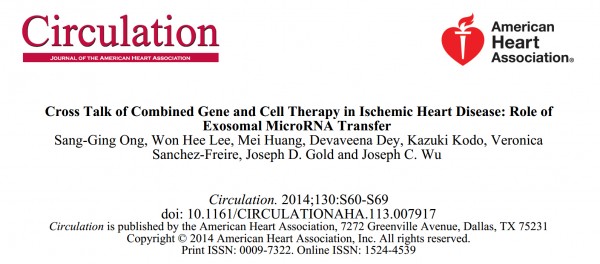
9月9日,Circulation上干细胞移植领域大牛Joseph C. Wu的最新文章介绍了在缺血性心脏病中基因与细胞治疗的联合能显著改善移植细胞的存活,其中外泌体RNA的转移其重要作用。
背景:
尽管研究表明干细胞移植治疗心梗更够显著改善心功能,但移植细胞的存活率低一直是个亟待解决的问题。低氧诱导因子(HIF1)能够介导缺血的适应反应。这里,作者猜想同时给心脏前体细胞(CPCs)和非病毒性携带HIF1的质粒(MC-HIF1)到缺血心肌能够改善心脏前体细胞的存活。
方法和结果:
心梗后6周,CPCs+MC-HIF1处理组的射血分数最大,为57.1±2.6%; P=0.002
其次是单独MC-HIF1处理组,为48.5±2.6%; P=0.04
接着是CPCs+MC-GFP处理组,为44.8±3.3%; P=NS
最低的是saline处理组,为38.7±3.2%.
体外的实验研究表明,心脏的内皮细胞产生的exosomes能被CPCs获取。过表达HIF1的内皮细胞产生的exosomes中miR-126和miR-210的水平较高。这些microRNAs在受体CPCs中激活促存活的激酶,诱导糖酵解转换,从而提高其低氧耐受性。抑制这些microRNAs会阻断exosomes的这些保护效应。
结论:
HIF1能够调节微环境,从而提高移植细胞的存活。外泌体的miRs的从宿主细胞到移植细胞的转移提示了一个潜在的靶点来改善移植细胞的存活。

原文来源:Ong, S. G., et al. (2014). "Cross Talk of Combined Gene and Cell Therapy in Ischemic Heart Disease: Role of Exosomal MicroRNA Transfer." Circulation 130(11 Suppl 1): S60-69.
Background—Despite the promise shown by stem cells for restoration of cardiac function after myocardial infarction, the poor survival of transplanted cells has been a major issue. Hypoxia-inducible factor-1 (HIF1) is a transcription factor that mediates adaptive responses to ischemia. Here, we hypothesize that codelivery of cardiac progenitor cells (CPCs) with a nonviral minicircle plasmid carrying HIF1 (MC-HIF1) into the ischemic myocardium can improve the survival of transplanted CPCs.
Methods and Results—After myocardial infarction, CPCs were codelivered intramyocardially into adult NOD/SCID mice with saline, MC-green fluorescent protein, or MC-HIF1 versus MC-HIF1 alone (n=10 per group). Bioluminescence imaging demonstrated better survival when CPCs were codelivered with MC-HIF1. Importantly, echocardiography showed mice injected with CPCs+MC-HIF1 had the highest ejection fraction 6 weeks after myocardial infarction (57.1±2.6%; P=0.002) followed by MC-HIF1 alone (48.5±2.6%; P=0.04), with no significant protection for CPCs+MC-green fluorescent protein (44.8±3.3%; P=NS) when compared with saline control (38.7±3.2%). In vitro mechanistic studies confirmed that cardiac endothelial cells produced exosomes that were actively internalized by recipient CPCs. Exosomes purified from endothelial cells overexpressing HIF1 had higher contents of miR-126 and miR-210. These microRNAs activated prosurvival kinases and induced a glycolytic switch in recipient CPCs, giving them increased tolerance when subjected to in vitro hypoxic stress. Inhibiting both of these miRs blocked the protective effects of the exosomes.
Conclusions—In summary, HIF1 can be used to modulate the host microenvironment for improving survival of transplanted cells. The exosomal transfer of miRs from host cells to transplanted cells represents a unique mechanism that can be potentially targeted for improving survival of transplanted cells.
版权归 外泌体资讯网 所有,未经书面许可,禁止转载。联系邮箱exosome@exosome.com.cn




